Organizational Behavior: Techniques to Improve Staff Motivation Levels
VerifiedAdded on 2023/06/07
|13
|2852
|163
Essay
AI Summary
This essay explores various techniques for enhancing staff motivation within an organizational setting, emphasizing the importance of motivation for overall workplace productivity. It differentiates between intrinsic and extrinsic motivation, providing real-life examples from the author's work experience to illustrate these concepts. The essay discusses strategies such as positive communication, employee empowerment, and career development opportunities, linking them to improved employee performance and reduced turnover. It also references Maslow's Hierarchy of Needs and Herzberg's Two-Factor Theory to explain how different organizational approaches can cater to employee needs and boost motivation. The analysis concludes that a comprehensive understanding and application of motivational techniques are crucial for fostering a competitive and efficient workforce.
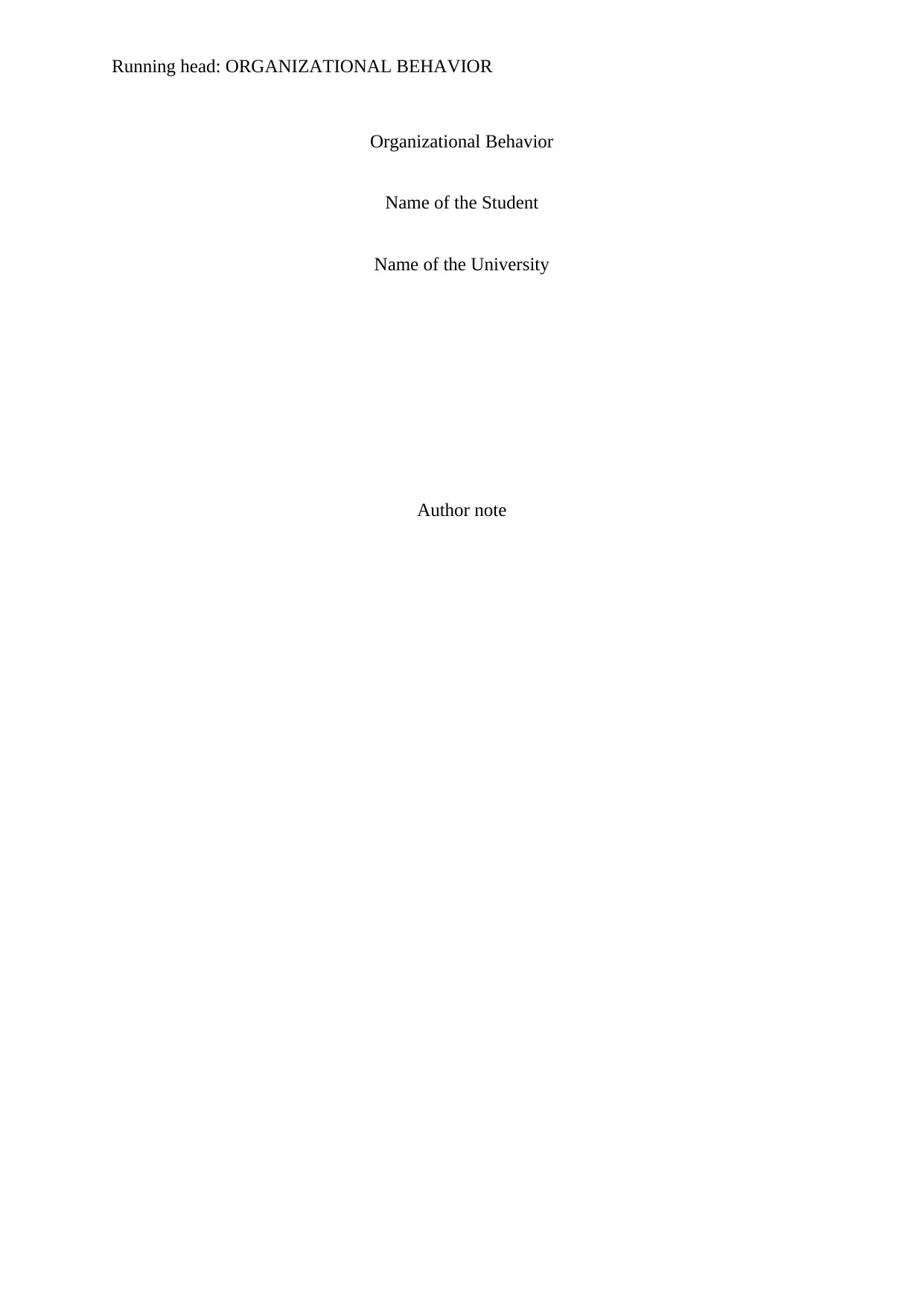
Running head: ORGANIZATIONAL BEHAVIOR
Organizational Behavior
Name of the Student
Name of the University
Author note
Organizational Behavior
Name of the Student
Name of the University
Author note
Paraphrase This Document
Need a fresh take? Get an instant paraphrase of this document with our AI Paraphraser
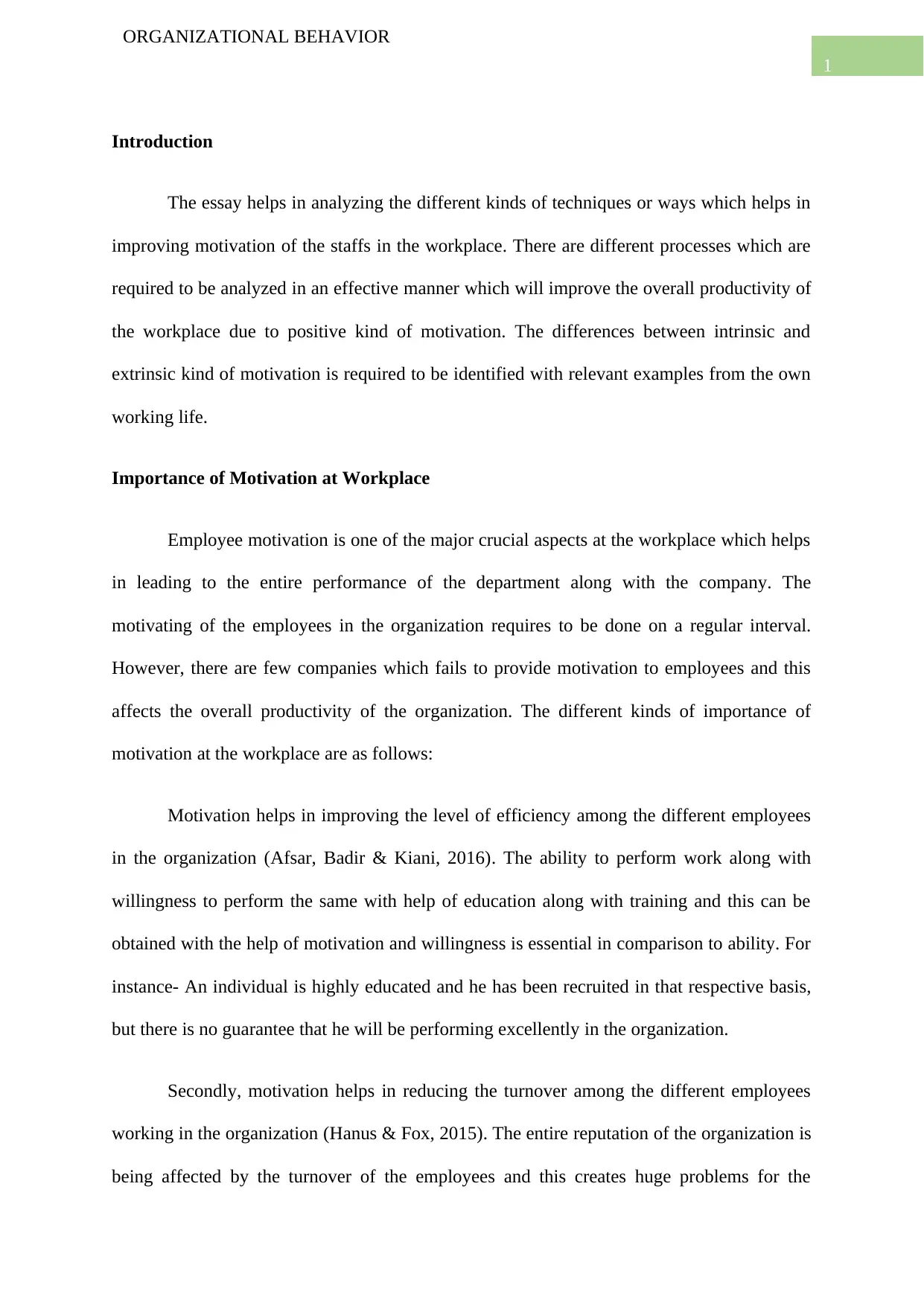
1
ORGANIZATIONAL BEHAVIOR
Introduction
The essay helps in analyzing the different kinds of techniques or ways which helps in
improving motivation of the staffs in the workplace. There are different processes which are
required to be analyzed in an effective manner which will improve the overall productivity of
the workplace due to positive kind of motivation. The differences between intrinsic and
extrinsic kind of motivation is required to be identified with relevant examples from the own
working life.
Importance of Motivation at Workplace
Employee motivation is one of the major crucial aspects at the workplace which helps
in leading to the entire performance of the department along with the company. The
motivating of the employees in the organization requires to be done on a regular interval.
However, there are few companies which fails to provide motivation to employees and this
affects the overall productivity of the organization. The different kinds of importance of
motivation at the workplace are as follows:
Motivation helps in improving the level of efficiency among the different employees
in the organization (Afsar, Badir & Kiani, 2016). The ability to perform work along with
willingness to perform the same with help of education along with training and this can be
obtained with the help of motivation and willingness is essential in comparison to ability. For
instance- An individual is highly educated and he has been recruited in that respective basis,
but there is no guarantee that he will be performing excellently in the organization.
Secondly, motivation helps in reducing the turnover among the different employees
working in the organization (Hanus & Fox, 2015). The entire reputation of the organization is
being affected by the turnover of the employees and this creates huge problems for the
ORGANIZATIONAL BEHAVIOR
Introduction
The essay helps in analyzing the different kinds of techniques or ways which helps in
improving motivation of the staffs in the workplace. There are different processes which are
required to be analyzed in an effective manner which will improve the overall productivity of
the workplace due to positive kind of motivation. The differences between intrinsic and
extrinsic kind of motivation is required to be identified with relevant examples from the own
working life.
Importance of Motivation at Workplace
Employee motivation is one of the major crucial aspects at the workplace which helps
in leading to the entire performance of the department along with the company. The
motivating of the employees in the organization requires to be done on a regular interval.
However, there are few companies which fails to provide motivation to employees and this
affects the overall productivity of the organization. The different kinds of importance of
motivation at the workplace are as follows:
Motivation helps in improving the level of efficiency among the different employees
in the organization (Afsar, Badir & Kiani, 2016). The ability to perform work along with
willingness to perform the same with help of education along with training and this can be
obtained with the help of motivation and willingness is essential in comparison to ability. For
instance- An individual is highly educated and he has been recruited in that respective basis,
but there is no guarantee that he will be performing excellently in the organization.
Secondly, motivation helps in reducing the turnover among the different employees
working in the organization (Hanus & Fox, 2015). The entire reputation of the organization is
being affected by the turnover of the employees and this creates huge problems for the
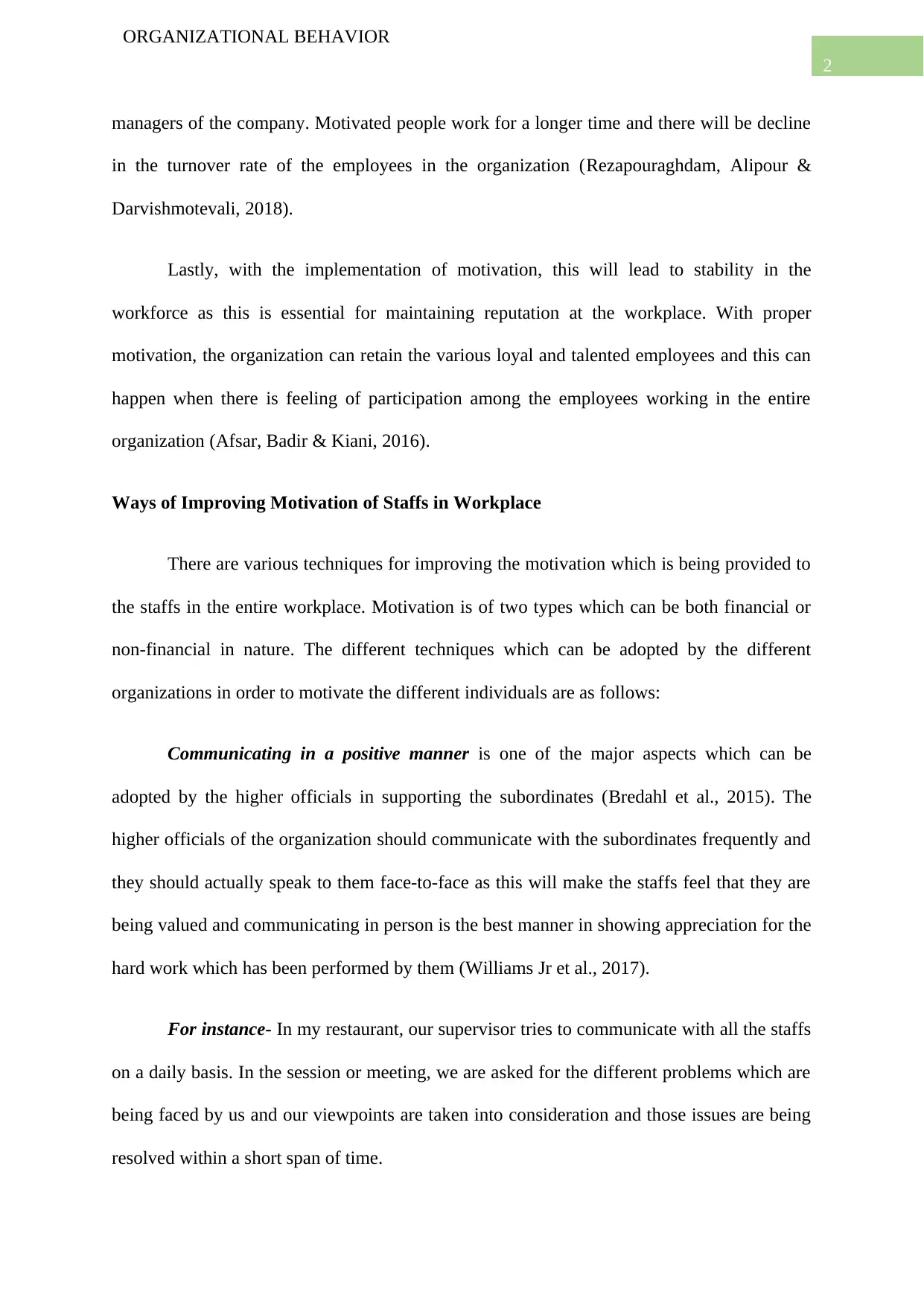
2
ORGANIZATIONAL BEHAVIOR
managers of the company. Motivated people work for a longer time and there will be decline
in the turnover rate of the employees in the organization (Rezapouraghdam, Alipour &
Darvishmotevali, 2018).
Lastly, with the implementation of motivation, this will lead to stability in the
workforce as this is essential for maintaining reputation at the workplace. With proper
motivation, the organization can retain the various loyal and talented employees and this can
happen when there is feeling of participation among the employees working in the entire
organization (Afsar, Badir & Kiani, 2016).
Ways of Improving Motivation of Staffs in Workplace
There are various techniques for improving the motivation which is being provided to
the staffs in the entire workplace. Motivation is of two types which can be both financial or
non-financial in nature. The different techniques which can be adopted by the different
organizations in order to motivate the different individuals are as follows:
Communicating in a positive manner is one of the major aspects which can be
adopted by the higher officials in supporting the subordinates (Bredahl et al., 2015). The
higher officials of the organization should communicate with the subordinates frequently and
they should actually speak to them face-to-face as this will make the staffs feel that they are
being valued and communicating in person is the best manner in showing appreciation for the
hard work which has been performed by them (Williams Jr et al., 2017).
For instance- In my restaurant, our supervisor tries to communicate with all the staffs
on a daily basis. In the session or meeting, we are asked for the different problems which are
being faced by us and our viewpoints are taken into consideration and those issues are being
resolved within a short span of time.
ORGANIZATIONAL BEHAVIOR
managers of the company. Motivated people work for a longer time and there will be decline
in the turnover rate of the employees in the organization (Rezapouraghdam, Alipour &
Darvishmotevali, 2018).
Lastly, with the implementation of motivation, this will lead to stability in the
workforce as this is essential for maintaining reputation at the workplace. With proper
motivation, the organization can retain the various loyal and talented employees and this can
happen when there is feeling of participation among the employees working in the entire
organization (Afsar, Badir & Kiani, 2016).
Ways of Improving Motivation of Staffs in Workplace
There are various techniques for improving the motivation which is being provided to
the staffs in the entire workplace. Motivation is of two types which can be both financial or
non-financial in nature. The different techniques which can be adopted by the different
organizations in order to motivate the different individuals are as follows:
Communicating in a positive manner is one of the major aspects which can be
adopted by the higher officials in supporting the subordinates (Bredahl et al., 2015). The
higher officials of the organization should communicate with the subordinates frequently and
they should actually speak to them face-to-face as this will make the staffs feel that they are
being valued and communicating in person is the best manner in showing appreciation for the
hard work which has been performed by them (Williams Jr et al., 2017).
For instance- In my restaurant, our supervisor tries to communicate with all the staffs
on a daily basis. In the session or meeting, we are asked for the different problems which are
being faced by us and our viewpoints are taken into consideration and those issues are being
resolved within a short span of time.
⊘ This is a preview!⊘
Do you want full access?
Subscribe today to unlock all pages.

Trusted by 1+ million students worldwide
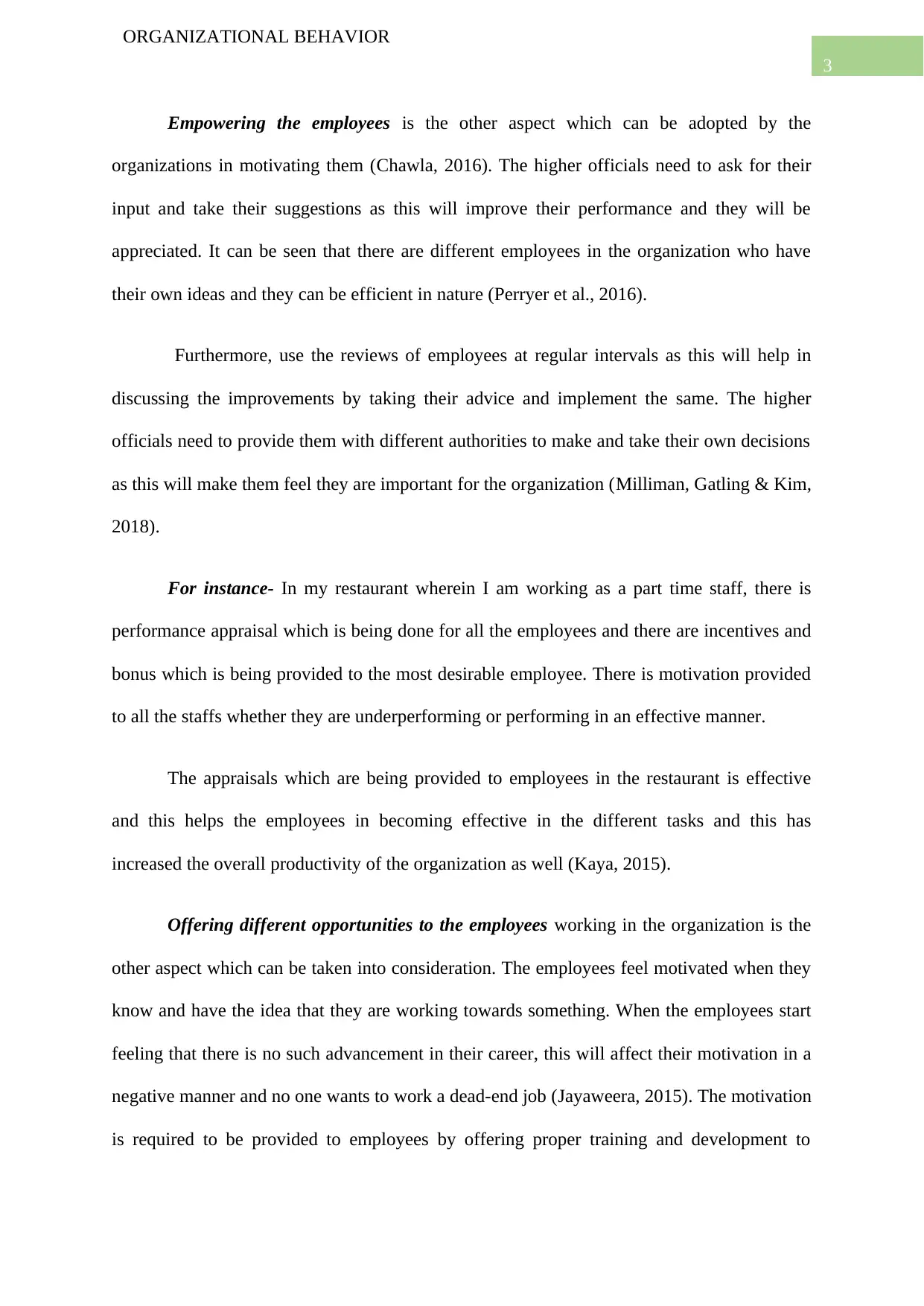
3
ORGANIZATIONAL BEHAVIOR
Empowering the employees is the other aspect which can be adopted by the
organizations in motivating them (Chawla, 2016). The higher officials need to ask for their
input and take their suggestions as this will improve their performance and they will be
appreciated. It can be seen that there are different employees in the organization who have
their own ideas and they can be efficient in nature (Perryer et al., 2016).
Furthermore, use the reviews of employees at regular intervals as this will help in
discussing the improvements by taking their advice and implement the same. The higher
officials need to provide them with different authorities to make and take their own decisions
as this will make them feel they are important for the organization (Milliman, Gatling & Kim,
2018).
For instance- In my restaurant wherein I am working as a part time staff, there is
performance appraisal which is being done for all the employees and there are incentives and
bonus which is being provided to the most desirable employee. There is motivation provided
to all the staffs whether they are underperforming or performing in an effective manner.
The appraisals which are being provided to employees in the restaurant is effective
and this helps the employees in becoming effective in the different tasks and this has
increased the overall productivity of the organization as well (Kaya, 2015).
Offering different opportunities to the employees working in the organization is the
other aspect which can be taken into consideration. The employees feel motivated when they
know and have the idea that they are working towards something. When the employees start
feeling that there is no such advancement in their career, this will affect their motivation in a
negative manner and no one wants to work a dead-end job (Jayaweera, 2015). The motivation
is required to be provided to employees by offering proper training and development to
ORGANIZATIONAL BEHAVIOR
Empowering the employees is the other aspect which can be adopted by the
organizations in motivating them (Chawla, 2016). The higher officials need to ask for their
input and take their suggestions as this will improve their performance and they will be
appreciated. It can be seen that there are different employees in the organization who have
their own ideas and they can be efficient in nature (Perryer et al., 2016).
Furthermore, use the reviews of employees at regular intervals as this will help in
discussing the improvements by taking their advice and implement the same. The higher
officials need to provide them with different authorities to make and take their own decisions
as this will make them feel they are important for the organization (Milliman, Gatling & Kim,
2018).
For instance- In my restaurant wherein I am working as a part time staff, there is
performance appraisal which is being done for all the employees and there are incentives and
bonus which is being provided to the most desirable employee. There is motivation provided
to all the staffs whether they are underperforming or performing in an effective manner.
The appraisals which are being provided to employees in the restaurant is effective
and this helps the employees in becoming effective in the different tasks and this has
increased the overall productivity of the organization as well (Kaya, 2015).
Offering different opportunities to the employees working in the organization is the
other aspect which can be taken into consideration. The employees feel motivated when they
know and have the idea that they are working towards something. When the employees start
feeling that there is no such advancement in their career, this will affect their motivation in a
negative manner and no one wants to work a dead-end job (Jayaweera, 2015). The motivation
is required to be provided to employees by offering proper training and development to
Paraphrase This Document
Need a fresh take? Get an instant paraphrase of this document with our AI Paraphraser
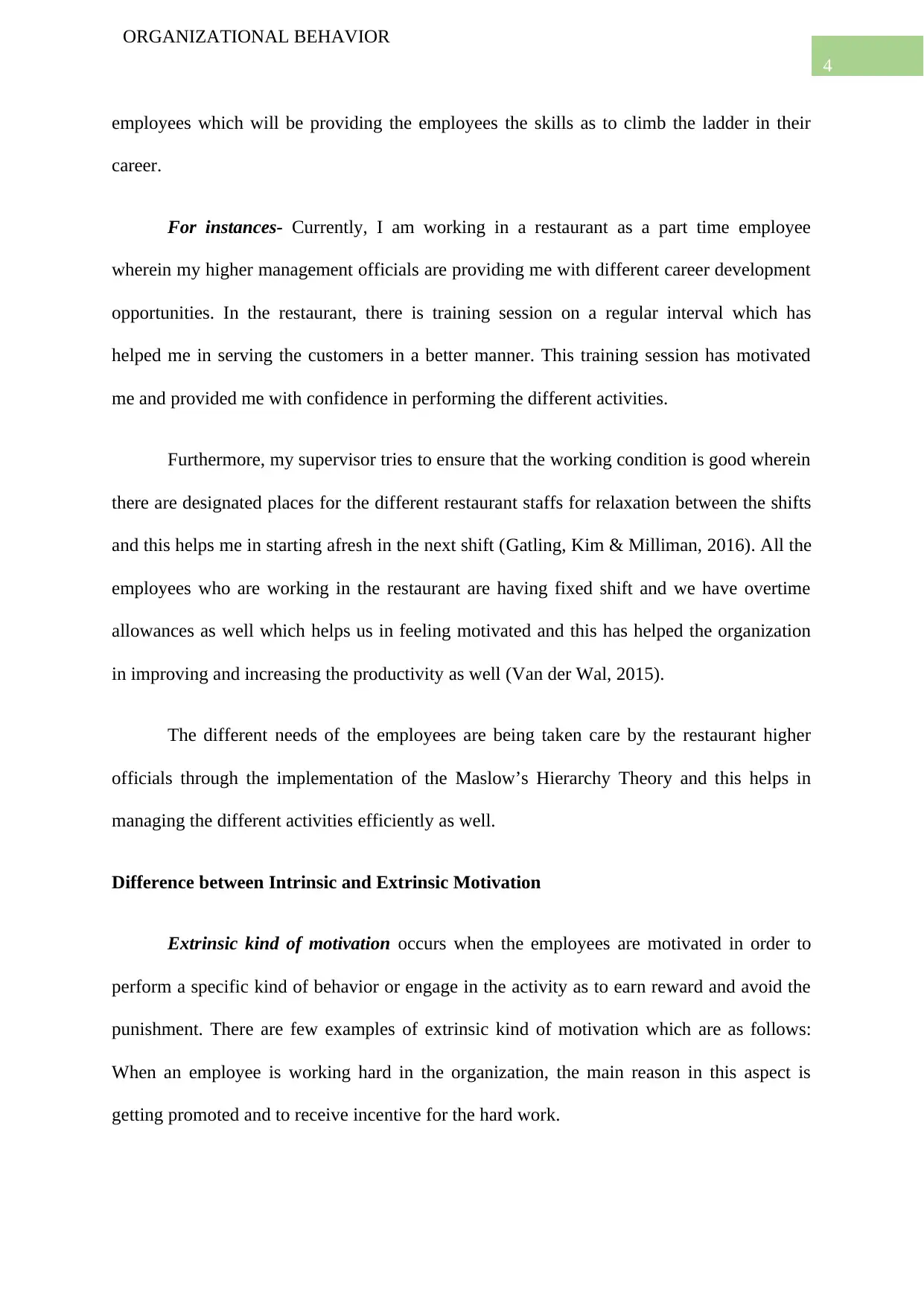
4
ORGANIZATIONAL BEHAVIOR
employees which will be providing the employees the skills as to climb the ladder in their
career.
For instances- Currently, I am working in a restaurant as a part time employee
wherein my higher management officials are providing me with different career development
opportunities. In the restaurant, there is training session on a regular interval which has
helped me in serving the customers in a better manner. This training session has motivated
me and provided me with confidence in performing the different activities.
Furthermore, my supervisor tries to ensure that the working condition is good wherein
there are designated places for the different restaurant staffs for relaxation between the shifts
and this helps me in starting afresh in the next shift (Gatling, Kim & Milliman, 2016). All the
employees who are working in the restaurant are having fixed shift and we have overtime
allowances as well which helps us in feeling motivated and this has helped the organization
in improving and increasing the productivity as well (Van der Wal, 2015).
The different needs of the employees are being taken care by the restaurant higher
officials through the implementation of the Maslow’s Hierarchy Theory and this helps in
managing the different activities efficiently as well.
Difference between Intrinsic and Extrinsic Motivation
Extrinsic kind of motivation occurs when the employees are motivated in order to
perform a specific kind of behavior or engage in the activity as to earn reward and avoid the
punishment. There are few examples of extrinsic kind of motivation which are as follows:
When an employee is working hard in the organization, the main reason in this aspect is
getting promoted and to receive incentive for the hard work.
ORGANIZATIONAL BEHAVIOR
employees which will be providing the employees the skills as to climb the ladder in their
career.
For instances- Currently, I am working in a restaurant as a part time employee
wherein my higher management officials are providing me with different career development
opportunities. In the restaurant, there is training session on a regular interval which has
helped me in serving the customers in a better manner. This training session has motivated
me and provided me with confidence in performing the different activities.
Furthermore, my supervisor tries to ensure that the working condition is good wherein
there are designated places for the different restaurant staffs for relaxation between the shifts
and this helps me in starting afresh in the next shift (Gatling, Kim & Milliman, 2016). All the
employees who are working in the restaurant are having fixed shift and we have overtime
allowances as well which helps us in feeling motivated and this has helped the organization
in improving and increasing the productivity as well (Van der Wal, 2015).
The different needs of the employees are being taken care by the restaurant higher
officials through the implementation of the Maslow’s Hierarchy Theory and this helps in
managing the different activities efficiently as well.
Difference between Intrinsic and Extrinsic Motivation
Extrinsic kind of motivation occurs when the employees are motivated in order to
perform a specific kind of behavior or engage in the activity as to earn reward and avoid the
punishment. There are few examples of extrinsic kind of motivation which are as follows:
When an employee is working hard in the organization, the main reason in this aspect is
getting promoted and to receive incentive for the hard work.
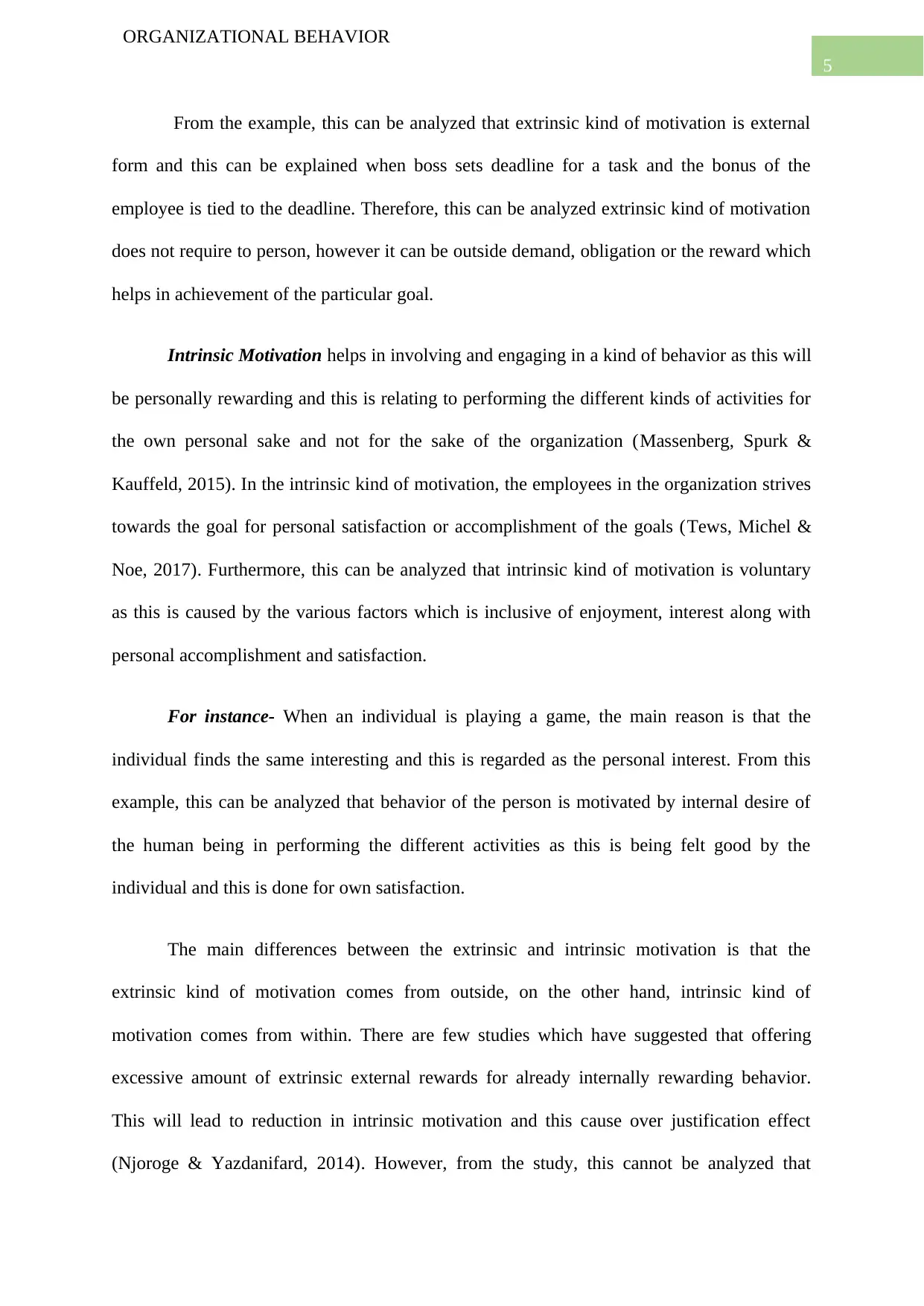
5
ORGANIZATIONAL BEHAVIOR
From the example, this can be analyzed that extrinsic kind of motivation is external
form and this can be explained when boss sets deadline for a task and the bonus of the
employee is tied to the deadline. Therefore, this can be analyzed extrinsic kind of motivation
does not require to person, however it can be outside demand, obligation or the reward which
helps in achievement of the particular goal.
Intrinsic Motivation helps in involving and engaging in a kind of behavior as this will
be personally rewarding and this is relating to performing the different kinds of activities for
the own personal sake and not for the sake of the organization (Massenberg, Spurk &
Kauffeld, 2015). In the intrinsic kind of motivation, the employees in the organization strives
towards the goal for personal satisfaction or accomplishment of the goals (Tews, Michel &
Noe, 2017). Furthermore, this can be analyzed that intrinsic kind of motivation is voluntary
as this is caused by the various factors which is inclusive of enjoyment, interest along with
personal accomplishment and satisfaction.
For instance- When an individual is playing a game, the main reason is that the
individual finds the same interesting and this is regarded as the personal interest. From this
example, this can be analyzed that behavior of the person is motivated by internal desire of
the human being in performing the different activities as this is being felt good by the
individual and this is done for own satisfaction.
The main differences between the extrinsic and intrinsic motivation is that the
extrinsic kind of motivation comes from outside, on the other hand, intrinsic kind of
motivation comes from within. There are few studies which have suggested that offering
excessive amount of extrinsic external rewards for already internally rewarding behavior.
This will lead to reduction in intrinsic motivation and this cause over justification effect
(Njoroge & Yazdanifard, 2014). However, from the study, this cannot be analyzed that
ORGANIZATIONAL BEHAVIOR
From the example, this can be analyzed that extrinsic kind of motivation is external
form and this can be explained when boss sets deadline for a task and the bonus of the
employee is tied to the deadline. Therefore, this can be analyzed extrinsic kind of motivation
does not require to person, however it can be outside demand, obligation or the reward which
helps in achievement of the particular goal.
Intrinsic Motivation helps in involving and engaging in a kind of behavior as this will
be personally rewarding and this is relating to performing the different kinds of activities for
the own personal sake and not for the sake of the organization (Massenberg, Spurk &
Kauffeld, 2015). In the intrinsic kind of motivation, the employees in the organization strives
towards the goal for personal satisfaction or accomplishment of the goals (Tews, Michel &
Noe, 2017). Furthermore, this can be analyzed that intrinsic kind of motivation is voluntary
as this is caused by the various factors which is inclusive of enjoyment, interest along with
personal accomplishment and satisfaction.
For instance- When an individual is playing a game, the main reason is that the
individual finds the same interesting and this is regarded as the personal interest. From this
example, this can be analyzed that behavior of the person is motivated by internal desire of
the human being in performing the different activities as this is being felt good by the
individual and this is done for own satisfaction.
The main differences between the extrinsic and intrinsic motivation is that the
extrinsic kind of motivation comes from outside, on the other hand, intrinsic kind of
motivation comes from within. There are few studies which have suggested that offering
excessive amount of extrinsic external rewards for already internally rewarding behavior.
This will lead to reduction in intrinsic motivation and this cause over justification effect
(Njoroge & Yazdanifard, 2014). However, from the study, this cannot be analyzed that
⊘ This is a preview!⊘
Do you want full access?
Subscribe today to unlock all pages.

Trusted by 1+ million students worldwide
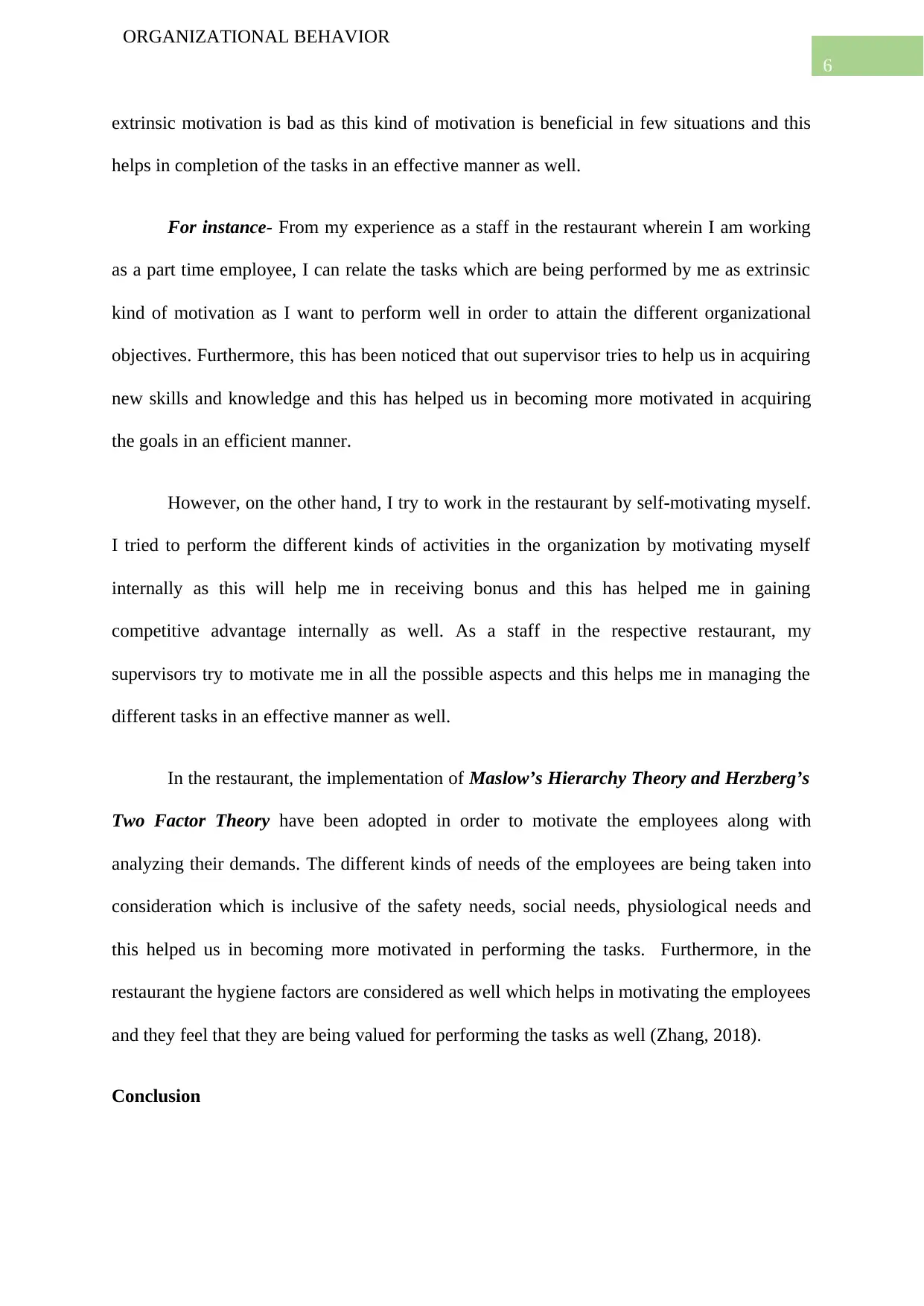
6
ORGANIZATIONAL BEHAVIOR
extrinsic motivation is bad as this kind of motivation is beneficial in few situations and this
helps in completion of the tasks in an effective manner as well.
For instance- From my experience as a staff in the restaurant wherein I am working
as a part time employee, I can relate the tasks which are being performed by me as extrinsic
kind of motivation as I want to perform well in order to attain the different organizational
objectives. Furthermore, this has been noticed that out supervisor tries to help us in acquiring
new skills and knowledge and this has helped us in becoming more motivated in acquiring
the goals in an efficient manner.
However, on the other hand, I try to work in the restaurant by self-motivating myself.
I tried to perform the different kinds of activities in the organization by motivating myself
internally as this will help me in receiving bonus and this has helped me in gaining
competitive advantage internally as well. As a staff in the respective restaurant, my
supervisors try to motivate me in all the possible aspects and this helps me in managing the
different tasks in an effective manner as well.
In the restaurant, the implementation of Maslow’s Hierarchy Theory and Herzberg’s
Two Factor Theory have been adopted in order to motivate the employees along with
analyzing their demands. The different kinds of needs of the employees are being taken into
consideration which is inclusive of the safety needs, social needs, physiological needs and
this helped us in becoming more motivated in performing the tasks. Furthermore, in the
restaurant the hygiene factors are considered as well which helps in motivating the employees
and they feel that they are being valued for performing the tasks as well (Zhang, 2018).
Conclusion
ORGANIZATIONAL BEHAVIOR
extrinsic motivation is bad as this kind of motivation is beneficial in few situations and this
helps in completion of the tasks in an effective manner as well.
For instance- From my experience as a staff in the restaurant wherein I am working
as a part time employee, I can relate the tasks which are being performed by me as extrinsic
kind of motivation as I want to perform well in order to attain the different organizational
objectives. Furthermore, this has been noticed that out supervisor tries to help us in acquiring
new skills and knowledge and this has helped us in becoming more motivated in acquiring
the goals in an efficient manner.
However, on the other hand, I try to work in the restaurant by self-motivating myself.
I tried to perform the different kinds of activities in the organization by motivating myself
internally as this will help me in receiving bonus and this has helped me in gaining
competitive advantage internally as well. As a staff in the respective restaurant, my
supervisors try to motivate me in all the possible aspects and this helps me in managing the
different tasks in an effective manner as well.
In the restaurant, the implementation of Maslow’s Hierarchy Theory and Herzberg’s
Two Factor Theory have been adopted in order to motivate the employees along with
analyzing their demands. The different kinds of needs of the employees are being taken into
consideration which is inclusive of the safety needs, social needs, physiological needs and
this helped us in becoming more motivated in performing the tasks. Furthermore, in the
restaurant the hygiene factors are considered as well which helps in motivating the employees
and they feel that they are being valued for performing the tasks as well (Zhang, 2018).
Conclusion
Paraphrase This Document
Need a fresh take? Get an instant paraphrase of this document with our AI Paraphraser
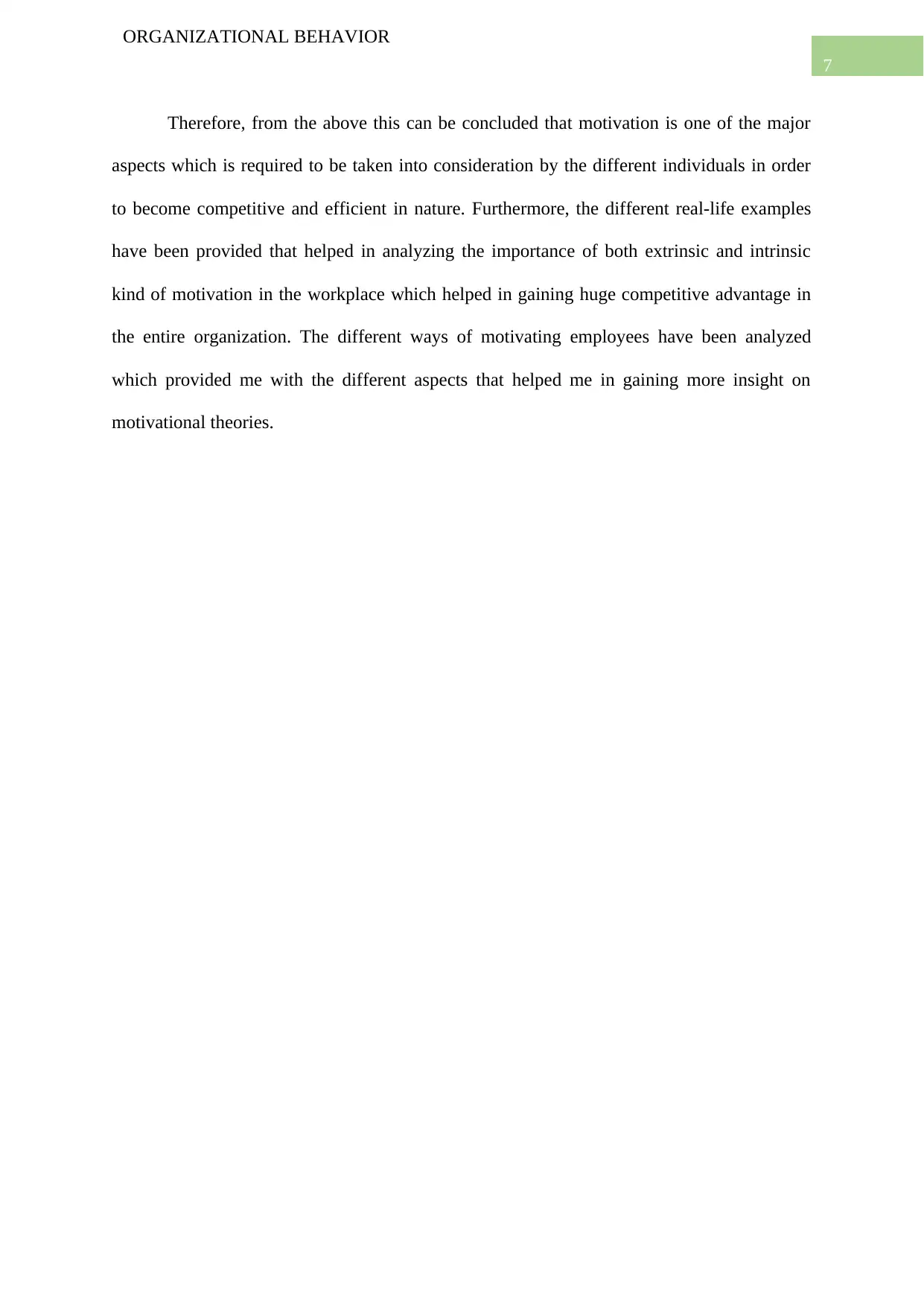
7
ORGANIZATIONAL BEHAVIOR
Therefore, from the above this can be concluded that motivation is one of the major
aspects which is required to be taken into consideration by the different individuals in order
to become competitive and efficient in nature. Furthermore, the different real-life examples
have been provided that helped in analyzing the importance of both extrinsic and intrinsic
kind of motivation in the workplace which helped in gaining huge competitive advantage in
the entire organization. The different ways of motivating employees have been analyzed
which provided me with the different aspects that helped me in gaining more insight on
motivational theories.
ORGANIZATIONAL BEHAVIOR
Therefore, from the above this can be concluded that motivation is one of the major
aspects which is required to be taken into consideration by the different individuals in order
to become competitive and efficient in nature. Furthermore, the different real-life examples
have been provided that helped in analyzing the importance of both extrinsic and intrinsic
kind of motivation in the workplace which helped in gaining huge competitive advantage in
the entire organization. The different ways of motivating employees have been analyzed
which provided me with the different aspects that helped me in gaining more insight on
motivational theories.
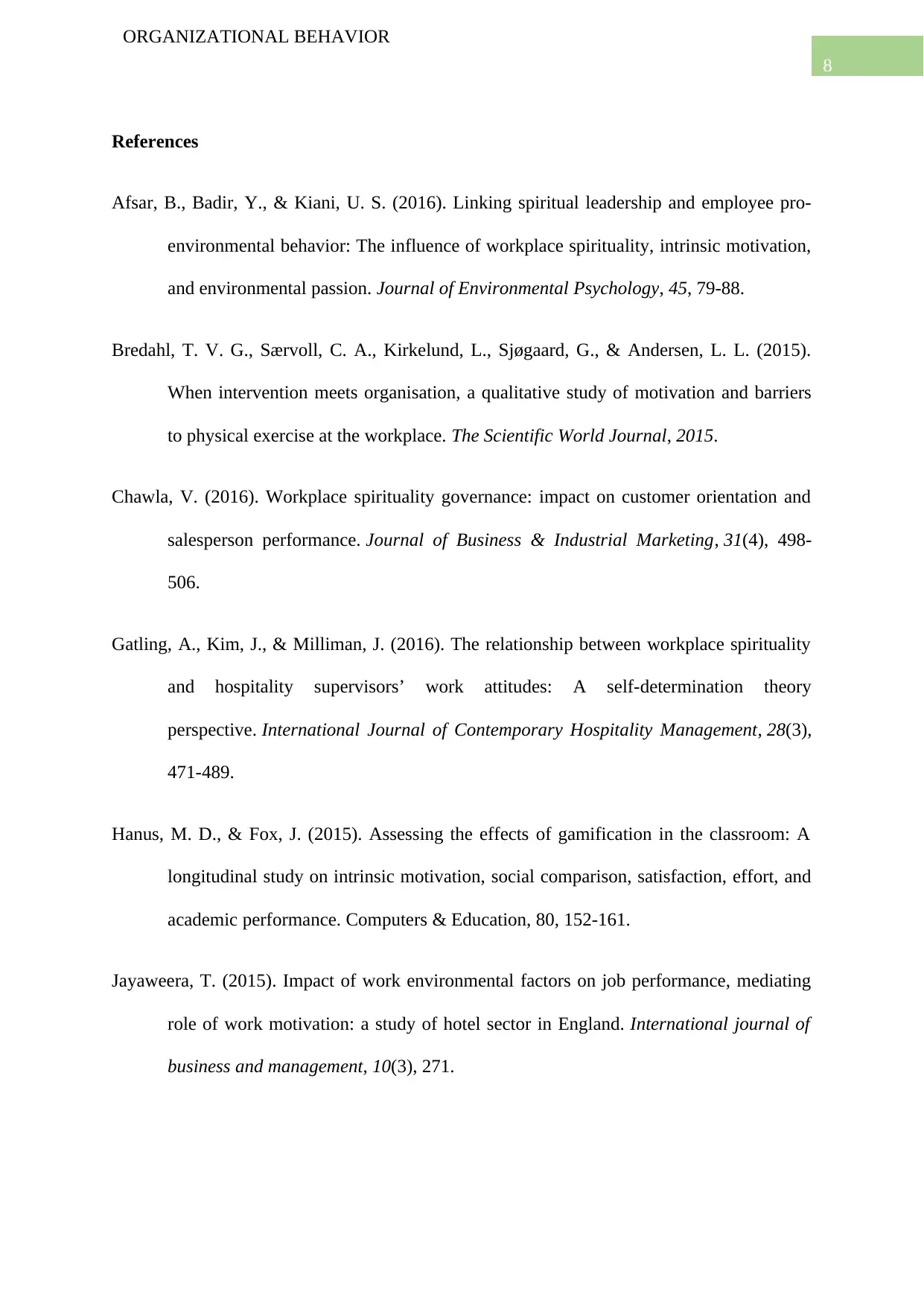
8
ORGANIZATIONAL BEHAVIOR
References
Afsar, B., Badir, Y., & Kiani, U. S. (2016). Linking spiritual leadership and employee pro-
environmental behavior: The influence of workplace spirituality, intrinsic motivation,
and environmental passion. Journal of Environmental Psychology, 45, 79-88.
Bredahl, T. V. G., Særvoll, C. A., Kirkelund, L., Sjøgaard, G., & Andersen, L. L. (2015).
When intervention meets organisation, a qualitative study of motivation and barriers
to physical exercise at the workplace. The Scientific World Journal, 2015.
Chawla, V. (2016). Workplace spirituality governance: impact on customer orientation and
salesperson performance. Journal of Business & Industrial Marketing, 31(4), 498-
506.
Gatling, A., Kim, J., & Milliman, J. (2016). The relationship between workplace spirituality
and hospitality supervisors’ work attitudes: A self-determination theory
perspective. International Journal of Contemporary Hospitality Management, 28(3),
471-489.
Hanus, M. D., & Fox, J. (2015). Assessing the effects of gamification in the classroom: A
longitudinal study on intrinsic motivation, social comparison, satisfaction, effort, and
academic performance. Computers & Education, 80, 152-161.
Jayaweera, T. (2015). Impact of work environmental factors on job performance, mediating
role of work motivation: a study of hotel sector in England. International journal of
business and management, 10(3), 271.
ORGANIZATIONAL BEHAVIOR
References
Afsar, B., Badir, Y., & Kiani, U. S. (2016). Linking spiritual leadership and employee pro-
environmental behavior: The influence of workplace spirituality, intrinsic motivation,
and environmental passion. Journal of Environmental Psychology, 45, 79-88.
Bredahl, T. V. G., Særvoll, C. A., Kirkelund, L., Sjøgaard, G., & Andersen, L. L. (2015).
When intervention meets organisation, a qualitative study of motivation and barriers
to physical exercise at the workplace. The Scientific World Journal, 2015.
Chawla, V. (2016). Workplace spirituality governance: impact on customer orientation and
salesperson performance. Journal of Business & Industrial Marketing, 31(4), 498-
506.
Gatling, A., Kim, J., & Milliman, J. (2016). The relationship between workplace spirituality
and hospitality supervisors’ work attitudes: A self-determination theory
perspective. International Journal of Contemporary Hospitality Management, 28(3),
471-489.
Hanus, M. D., & Fox, J. (2015). Assessing the effects of gamification in the classroom: A
longitudinal study on intrinsic motivation, social comparison, satisfaction, effort, and
academic performance. Computers & Education, 80, 152-161.
Jayaweera, T. (2015). Impact of work environmental factors on job performance, mediating
role of work motivation: a study of hotel sector in England. International journal of
business and management, 10(3), 271.
⊘ This is a preview!⊘
Do you want full access?
Subscribe today to unlock all pages.

Trusted by 1+ million students worldwide
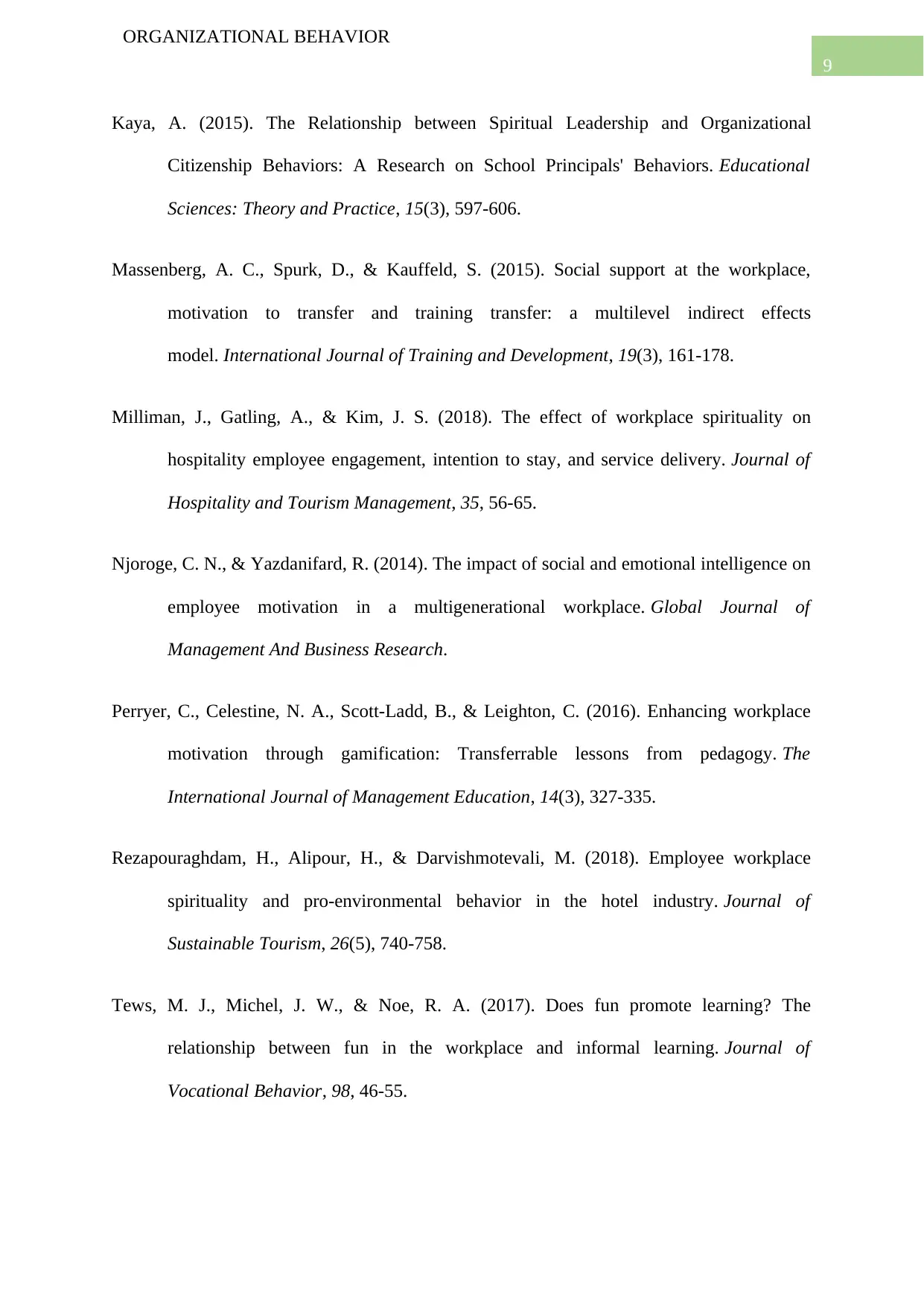
9
ORGANIZATIONAL BEHAVIOR
Kaya, A. (2015). The Relationship between Spiritual Leadership and Organizational
Citizenship Behaviors: A Research on School Principals' Behaviors. Educational
Sciences: Theory and Practice, 15(3), 597-606.
Massenberg, A. C., Spurk, D., & Kauffeld, S. (2015). Social support at the workplace,
motivation to transfer and training transfer: a multilevel indirect effects
model. International Journal of Training and Development, 19(3), 161-178.
Milliman, J., Gatling, A., & Kim, J. S. (2018). The effect of workplace spirituality on
hospitality employee engagement, intention to stay, and service delivery. Journal of
Hospitality and Tourism Management, 35, 56-65.
Njoroge, C. N., & Yazdanifard, R. (2014). The impact of social and emotional intelligence on
employee motivation in a multigenerational workplace. Global Journal of
Management And Business Research.
Perryer, C., Celestine, N. A., Scott-Ladd, B., & Leighton, C. (2016). Enhancing workplace
motivation through gamification: Transferrable lessons from pedagogy. The
International Journal of Management Education, 14(3), 327-335.
Rezapouraghdam, H., Alipour, H., & Darvishmotevali, M. (2018). Employee workplace
spirituality and pro-environmental behavior in the hotel industry. Journal of
Sustainable Tourism, 26(5), 740-758.
Tews, M. J., Michel, J. W., & Noe, R. A. (2017). Does fun promote learning? The
relationship between fun in the workplace and informal learning. Journal of
Vocational Behavior, 98, 46-55.
ORGANIZATIONAL BEHAVIOR
Kaya, A. (2015). The Relationship between Spiritual Leadership and Organizational
Citizenship Behaviors: A Research on School Principals' Behaviors. Educational
Sciences: Theory and Practice, 15(3), 597-606.
Massenberg, A. C., Spurk, D., & Kauffeld, S. (2015). Social support at the workplace,
motivation to transfer and training transfer: a multilevel indirect effects
model. International Journal of Training and Development, 19(3), 161-178.
Milliman, J., Gatling, A., & Kim, J. S. (2018). The effect of workplace spirituality on
hospitality employee engagement, intention to stay, and service delivery. Journal of
Hospitality and Tourism Management, 35, 56-65.
Njoroge, C. N., & Yazdanifard, R. (2014). The impact of social and emotional intelligence on
employee motivation in a multigenerational workplace. Global Journal of
Management And Business Research.
Perryer, C., Celestine, N. A., Scott-Ladd, B., & Leighton, C. (2016). Enhancing workplace
motivation through gamification: Transferrable lessons from pedagogy. The
International Journal of Management Education, 14(3), 327-335.
Rezapouraghdam, H., Alipour, H., & Darvishmotevali, M. (2018). Employee workplace
spirituality and pro-environmental behavior in the hotel industry. Journal of
Sustainable Tourism, 26(5), 740-758.
Tews, M. J., Michel, J. W., & Noe, R. A. (2017). Does fun promote learning? The
relationship between fun in the workplace and informal learning. Journal of
Vocational Behavior, 98, 46-55.
Paraphrase This Document
Need a fresh take? Get an instant paraphrase of this document with our AI Paraphraser
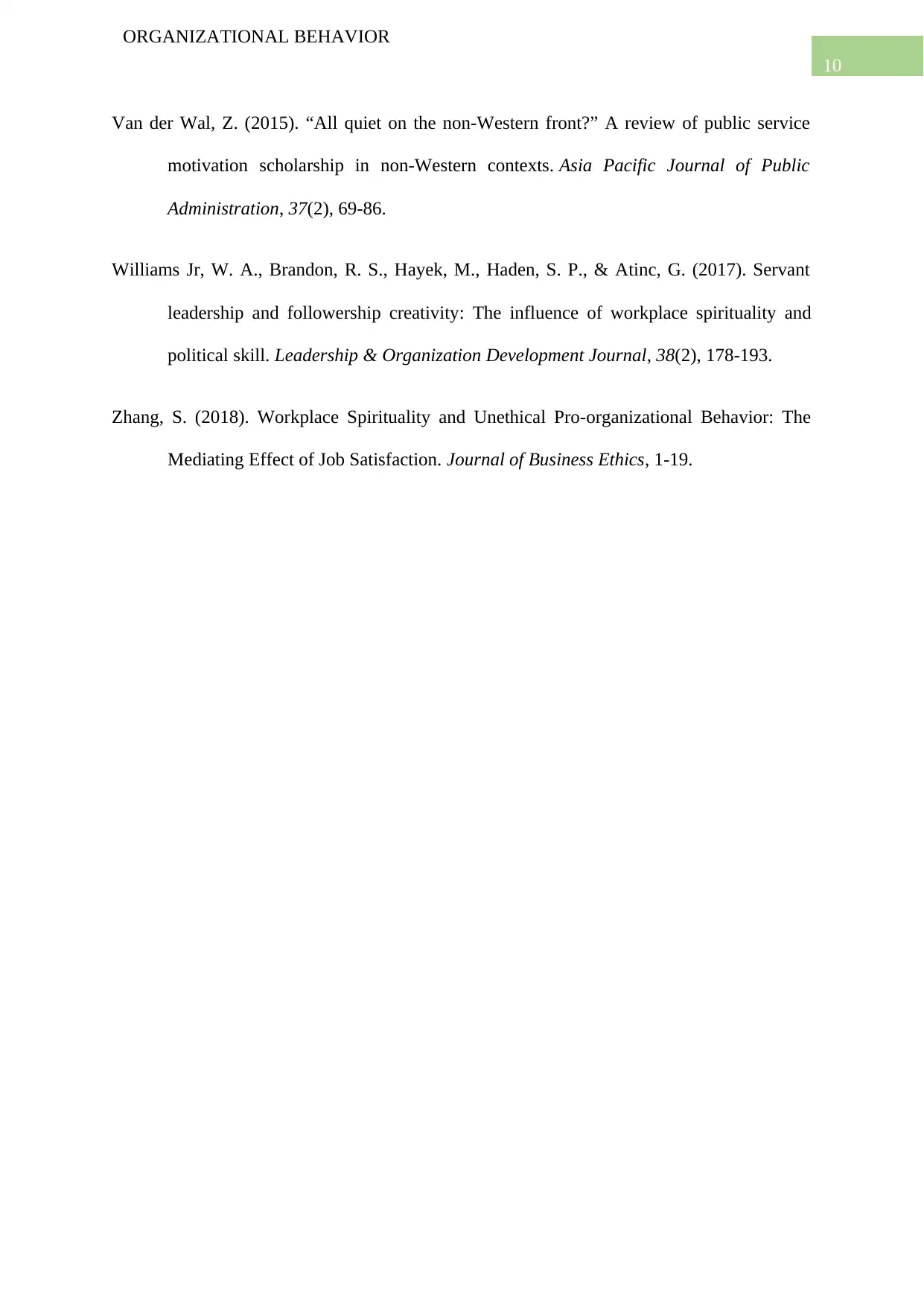
10
ORGANIZATIONAL BEHAVIOR
Van der Wal, Z. (2015). “All quiet on the non-Western front?” A review of public service
motivation scholarship in non-Western contexts. Asia Pacific Journal of Public
Administration, 37(2), 69-86.
Williams Jr, W. A., Brandon, R. S., Hayek, M., Haden, S. P., & Atinc, G. (2017). Servant
leadership and followership creativity: The influence of workplace spirituality and
political skill. Leadership & Organization Development Journal, 38(2), 178-193.
Zhang, S. (2018). Workplace Spirituality and Unethical Pro-organizational Behavior: The
Mediating Effect of Job Satisfaction. Journal of Business Ethics, 1-19.
ORGANIZATIONAL BEHAVIOR
Van der Wal, Z. (2015). “All quiet on the non-Western front?” A review of public service
motivation scholarship in non-Western contexts. Asia Pacific Journal of Public
Administration, 37(2), 69-86.
Williams Jr, W. A., Brandon, R. S., Hayek, M., Haden, S. P., & Atinc, G. (2017). Servant
leadership and followership creativity: The influence of workplace spirituality and
political skill. Leadership & Organization Development Journal, 38(2), 178-193.
Zhang, S. (2018). Workplace Spirituality and Unethical Pro-organizational Behavior: The
Mediating Effect of Job Satisfaction. Journal of Business Ethics, 1-19.
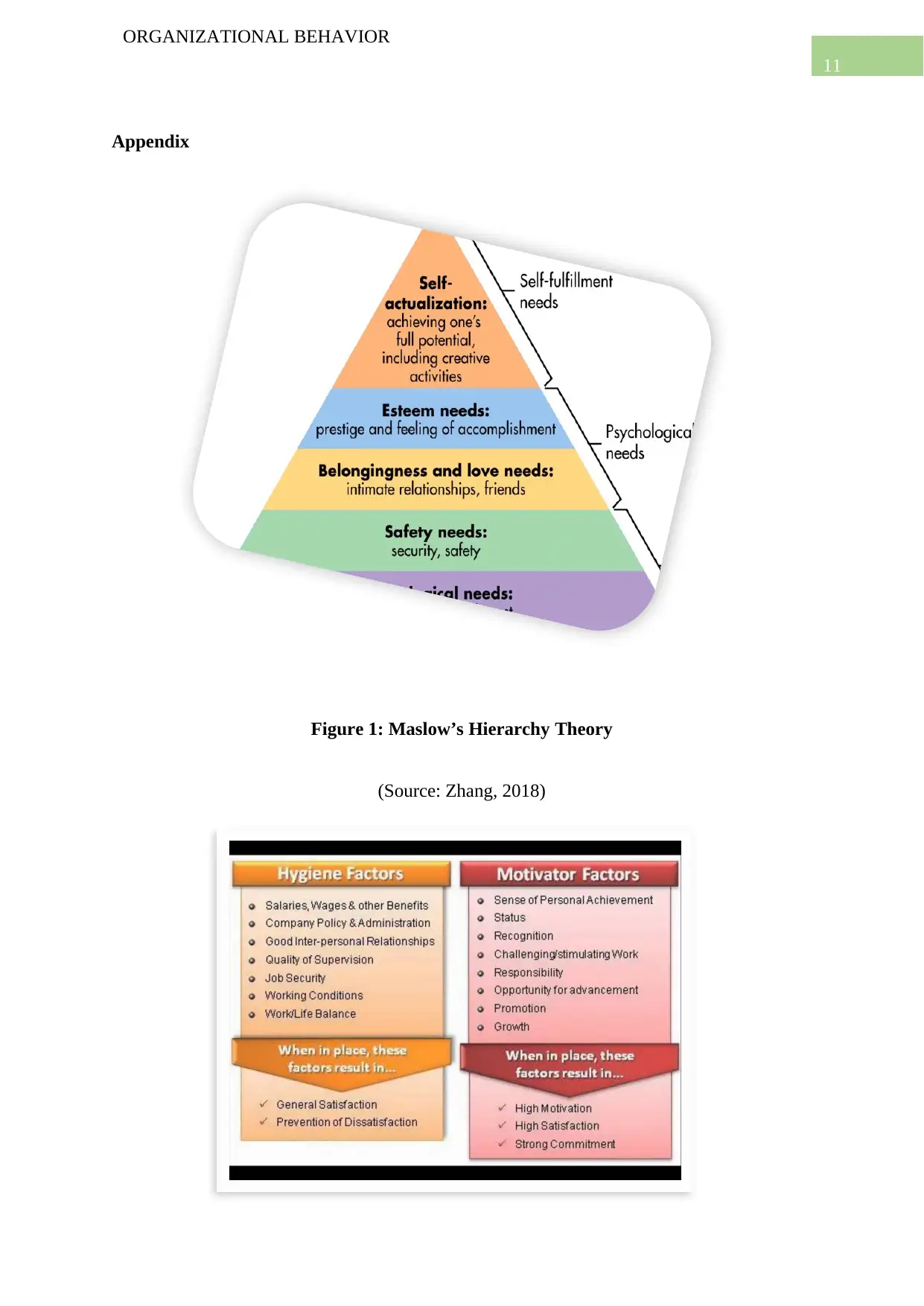
11
ORGANIZATIONAL BEHAVIOR
Appendix
Figure 1: Maslow’s Hierarchy Theory
(Source: Zhang, 2018)
ORGANIZATIONAL BEHAVIOR
Appendix
Figure 1: Maslow’s Hierarchy Theory
(Source: Zhang, 2018)
⊘ This is a preview!⊘
Do you want full access?
Subscribe today to unlock all pages.

Trusted by 1+ million students worldwide
1 out of 13
Related Documents
Your All-in-One AI-Powered Toolkit for Academic Success.
+13062052269
info@desklib.com
Available 24*7 on WhatsApp / Email
![[object Object]](/_next/static/media/star-bottom.7253800d.svg)
Unlock your academic potential
Copyright © 2020–2025 A2Z Services. All Rights Reserved. Developed and managed by ZUCOL.




